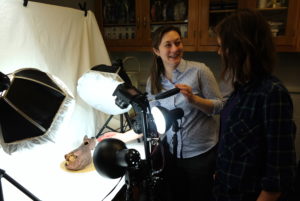
A.L. McMichael is a historian of art, architecture, and design. In praxis she specializes in designed systems and administration. Her current role is Director of the Lab for Education and Advancement in Digital Research (LEADR) at Michigan State University. She holds a PhD in Early Christian and Byzantine Art and Architecture from The Graduate Center of the City University of New York (CUNY), an MA in Art History from Brooklyn College, and a BFA in Graphic Design from Auburn University. She was a GC Digital Fellow from 2012 to 2015.
GC Digital Initiatives Program Coordinator Ian Wallace—who is also a PhD Candidate in Art History at the GC—caught up with A.L. by e-mail to see how her fellowship experience has influenced her work.
What have you been up to since your fellowship concluded?
As of last August, I am the Director of the Lab for Education and Advancement in Digital Research (LEADR) at Michigan State University. Generally speaking, the lab’s mission is to incorporate digital research into the curricula of the History and Anthropology departments. I began working here in 2016 as Assistant Director. Each spring I teach a digital methods course, and I also collaborate with over a dozen faculty members each year to design digital humanities assignments that we scaffold throughout the semester. The methodologies we teach range from 3D data visualization to interactive mapping to navigating information architecture on the web. Teaching Digital Fellows workshops at the GC was an excellent crash course in digital pedagogy that I use every day.
My lab’s class projects are taught as a series of workshops and consultations led by one of the four Graduate Assistants in LEADR. Grad Assistants work in the lab as their PhD funding appointment for the academic year. Helping them create a teaching philosophy based on ethics and empowerment of students is, for me, a highlight of being a lab director. This “teach the teachers” approach is one the GC Digital Fellows are committed to as well, and I think it is our best chance at bringing positive change to higher education.
Did the fellowship help to prepare you for your current endeavors in any particular way?
One big takeaway of the fellowship was the opportunity to see “behind the curtain” of university administration. We were involved in discussions about grant applications, funding, proposing and developing courses and programs, publishing, pedagogical theory and application, and so many other aspects of higher ed that you just don’t see during most student jobs or in coursework. We learned to advocate for ourselves and our digital work, and how to present that work to funders, administrators, and potential collaborators in ways that showcased what the group had accomplished. This knowledge has been extremely beneficial to my current work because I have an appointment in two departments and collaborate regularly across colleges with DH@MSU, the library’s Digital Scholarship Lab, Matrix, and the Campus Archaeology Program, among others. It really helps to understand administrative structures and motivations of decision makers when I advocate for resources or want to examine how my students’ work can have a wider impact in the community.
I describe my field as the history and praxis of design. My research is on Byzantine Architecture, especially the multisensory experiences that a monument’s creators facilitate. Along the same lines, I think of being a lab administrator as experiential design—I combine knowledge of historical design systems with my previous experience in publication design and editorial art direction. Similarly to the ways Digital Fellows advocate for a progressive, varied approach to technologies in the curriculum, my lab staff and I construct a variety of pedagogical experiences, design lesson plans, develop teaching strategies, and create systems for distributing information and managing equipment. Graduate Assistants also gain expertise in teaching digital research methods to undergraduate students who are learning to design their own projects. It has been really cool to tie together seemingly loose threads to show how effective research design promotes quality of life and education, both now and throughout history.
As a fellow art historian, I’m curious to know how you see digital skills intersecting with the discipline.
As I mentioned above, design is a theme that resonates with my identity as an art historian and digital humanist in lots of ways. You could just as easily label my field “visual and material studies.” To that end, my art historical work uses number of digital methods that intersect with archaeology. In the lab we do a lot of photogrammetry (3D modeling using photographs or drone footage as data). I recently received a Catalyst Grant from MSU’s HUB for Innovation in Learning and Technology to incorporate vector drawing into a history class. Students will learn to visualize and convey relationships between monuments and landscapes using Virtual Reality and 360 immersion displays. I am also using 3D models in my research as both documentation of monuments and visualization of data from texts or archaeological evidence.
What was it like to work alongside other fellows from disciplines outside your own?
The Best! Seriously, working in the Digital Fellows cohort (and simultaneously in the New Media Lab) was my first opportunity to collaborate with social scientists and think about ways “humanities” and “interdisciplinary” research methodologies span seemingly disparate disciplines. For instance, by helping this art historian understand the frameworks of anthropology, human geography, and sociology my colleagues were actually preparing me for the work I do now, which is directing a social science research lab and looking at ways these disciplines intersect with digital humanities.
Have you kept in touch with any of your cohort?
Yep. We’re spread across the entire country these days, but it’s always nice to catch up at conferences or even just say hello in the social media realm.
Find out more about the Lab for the Education and Advancement in Digital Research at Michigan State University at leadr.msu.edu.



